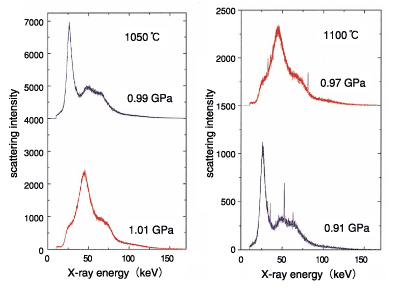 |
||
|
 |
||
|
| It is well known that there are three states of matter; solid, liquid and gas. Transforma-tions between these states are accompanied by changes in atomic arrangement and density. Such transformations are called first-order phase transitions. Other examples of first-order phase transitions are observed in crystalline solids, solids formed by a repeating pattern of atoms. By a change of pressure or temperature, some crystalline solids abruptly transform to other structures with different atomic arrangement and density. It has not been generally thought however, that liquids of pure substances undergo first order phase transitions, i.e., transitions between two liquid forms which are distinguished by atomic arrangement and density. However, we have found evidence for such a transformation. We carried out X-ray diffraction experiments on liquid phosphorus using the JAERI Materials Science I beamline (BL14B1) at the SPring-8, and a high-pressure high-temperature generation system. In the experiments, a molecular liquid that consists of P4 tetrahedral molecules was observed below about 10,000 bar, whereas a network structure formed by P atoms was observed at higher pressures. In addition, we observed abrupt transformations between the two liquid forms by a decrease or an increase of the pressure. These results strongly support the theory that the transformation is a first-order phase transition. This study indicates that an abrupt structural change does occur in a liquid of a pure substance by an in-situ observation. This finding is not only a contribution to development of basic science such as physics and chemistry, but also to research on the earth's magma and synthesis of new materials under high-temperature and high-pressure conditions. |
| Reference Y. Katayama et al., A First-Order Liquid-Liquid Phase Transition in Phosphorus, Nature, 403(6766), 170 (2000). |
| Select a topic in left column |
|
Persistent Quest-Research Activities 2000 Copyright(c)Japan Atomic Energy Research Institute |